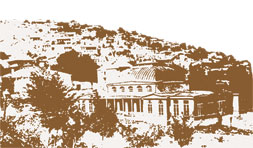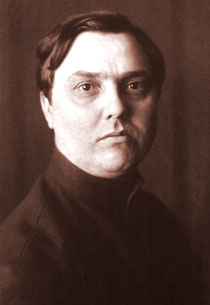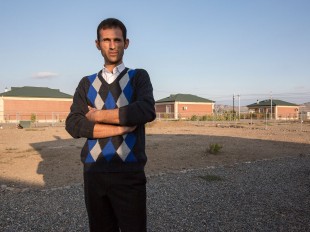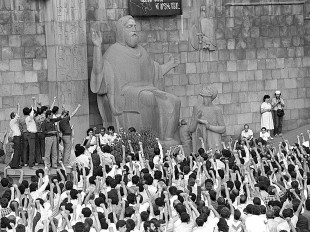Pages 54-57
by Ilgar Niftaliyev
When Nakhchivan was granted autonomous status in 1921 and the Autonomous Region of Nagorno-Karabagh (ARNK) was formed in 1923 as part of the Azerbaijan Soviet Socialist Republic (the original name of the ARNK before ratification of the second Constitution of the USSR in 1936) all Armenian territorial claims on Azerbaijan were laid to rest.
New claim
However, the situation changed after the Second World War. New territorial claims were launched by the leadership of the Armenian Soviet Socialist Republic. Grigory Arutyunov Secretary of the Central Committee of the Communist Party of the Armenian Soviet Socialist Republic, sent a telegram to Georgy Malenkov, Secretary of the Central Committee of the All-Russian Communist Party, trying to “give reasons” to transfer the ARNK to the Armenian Soviet Socialist Republic1. As Ruben Angaladyan, Armenian researcher and author of a book on Anastas Mikoyan, states, “Grigory Arutyunov could not have taken such a step without consulting Mikoyan. We must remember that Arutyunov’s daughter was Mikoyan’s daughter-in-law, the wife of his son, Alexey. So Mikoyan had, without doubt, been informed about these letters.”2
Rebuttal and withdrawal
When Malenkov forwarded Arutyunov´s telegram to Mir Jafar Baghirov, first secretary of the Central Committee of the Communist Party of Azerbaijan, on 28 November 19453, the Azerbaijani leader prepared a comprehensive response and sent it to Malenkov on 10 December 1945, together with an inquiry into the political history of Karabagh. Baghirov disproved Arutyunov’s ‘case’ in toto. 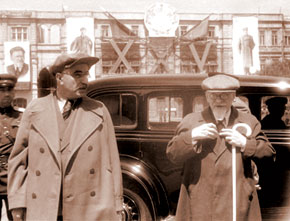 M.J.Bagirov, First Secretary of the Azerbaijani Communist (Bolshevik) Party, and M.I.Kalinin, Chairman of the Supreme Presidium Staff of the USSR, at the 25th Anniversary of the establishment of Soviet power in Azerbaijan. 1945 At the end of the letter, Baghirov made a counter-proposal to transfer back former Azerbaijani territories, inhabited by Azerbaijanis but within the structure of the Armenian Soviet Socialist Republic; these included Azizbekov, Vedi and Karabaglar4. The Armenian leadership then withdrew the question from the agenda and returned to it only after Stalin´s death.
M.J.Bagirov, First Secretary of the Azerbaijani Communist (Bolshevik) Party, and M.I.Kalinin, Chairman of the Supreme Presidium Staff of the USSR, at the 25th Anniversary of the establishment of Soviet power in Azerbaijan. 1945 At the end of the letter, Baghirov made a counter-proposal to transfer back former Azerbaijani territories, inhabited by Azerbaijanis but within the structure of the Armenian Soviet Socialist Republic; these included Azizbekov, Vedi and Karabaglar4. The Armenian leadership then withdrew the question from the agenda and returned to it only after Stalin´s death.
National development / nationalist expansion
The thaw in the USSR’s political regime that began after Stalin´s death promoted greater sensitivity by the state to the moods of society. The 20th Congress of the CPSU, which took place in February 1956 and at which the new Soviet party leader, Nikita Khrushchev, denounced the personality cult surrounding Stalin, was the culmination of this process. As one historian accurately noted, the outcomes of the 20th Congress were received differently in the Soviet republics of the Southern Caucasus: “While they stimulated a struggle in Azerbaijan for development of the national language and values, in Armenia they revived the idea of making territorial claims on neighbouring republics and Turkey”5. A decree by the Presidium of the Supreme Council of the USSR, dated 19 February 1954, ‘On transferring the Crimean region from the RSFSR to the USSR’, on the tercentenary of Ukraine’s union with Russia, stimulated Armenian hopes of a revision of the borders.
New claim
The new campaign of territorial claims on Azerbaijan was not simply organised at party leadership level in Armenia. Signatures were collected and petitions and appeals made to the higher allied party and state bodies by various social groups. The key role thus belonged to radical intellectuals, who were important players in the heightening of interethnic tension with Azerbaijanis, especially, in the post-Stalin period. Prominent among the intellectuals were elements who were gaining popularity on the field of ethnic and national confrontation. So, in April 1956, Suren Tovmasyan, the new First Secretary of the Central Committee of the CP of the Armenian Soviet Socialist Republic, specified in a message to Moscow that a party meeting at one of the high schools and a session of the Writers’ Union of Armenia had made appeals for a revision of the borders with the Azerbaijan Soviet Socialist Republic6.
Church and politics
The Armenian-Gregorian Church, which had renewed its work after the Second World War, made its own contribution to heightening the nationalist mood among Armenians. For the Armenian-Gregorian Church, nationalist and political aims traditionally prevailed over religious function and it had long since served as a bond for Armenians who, after the loss of their own statehood, had been living as a broad diaspora. It is no coincidence that Catholicos Vazgen I, in a letter dated 12 May 1956 and addressed to Nikolai Bulganin, Chairman of the Council of Ministers of the USSR, tried to present the territorial claims on Georgia and Azerbaijan as primarily the demands of the Armenian Diaspora7. Although the questions raised in the letter went unanswered, the fact that this appeal to the Soviet leadership was made not by the Armenian party leader, but by the leading cleric was testimony that the Armenian elite, having tasted some freedom following ‘the thaw’ after Stalin’s death, had renewed their active attempts at expansion8.
The claim-again sixties
The 60s were marked by a stepping up of Armenian territorial claims. Operational information received by the ARNK KGB of the Azerbaijan Soviet Socialist Republic in May 1962, stresses that “some people in Stepanakert are spreading rumours about secession by the ARNK from Azerbaijan and joining Armenia. Signatures are being collected illegally for an appeal to the central authorities to allow union with Armenia. A similar appeal, signed by leading representatives of Karabagh intellectuals has already been directed to Moscow”. On 24 June 1962, the KGB of the Azerbaijan Soviet Socialist Republic received the following information: “In connection with Khruschev’s forthcoming visit to Armenia, rumours are circulating among the Armenian population of the region that once in Armenia, Khrushchev is going to present the country with the Nagorno-Karabagh region as a gift to commemorate the republic’s 40th anniversary9.
The next round of the antiAzerbaijani campaign coincided with preparations by the Armenian Soviet Socialist Republic for the 50th anniversary of the notorious events of 1915 in the Ottoman Empire. During this period in the Armenian Soviet Socialist Republic, Azerbaijanis were banned from supervisory posts, regional Azerbaijani-language newspapers were closed down, Yerevan’s Jafar Jabbarli Azerbaijani Drama Theatre ceased work and, at the same time, the ‘Karabagh Committee’ began to operate openly10.
Interference in internal affairs fails again
A change in the country’s leadership and Leonid Brezhnev’s arrival in office raised hopes among Armenia’s political elite of a favourable response to their territorial claims. On 30 September 1966, a letter signed by Anton Kochinyan, First Secretary of the Central Committee of the CP of the Armenian Soviet Socialist Republic, and Badal Muradyan, chairman of the Council of Ministers, which was presented as “the request of a group of scientists and cultural workers of the Armenian Soviet Socialist Republic to the 23rd party congress” was sent to the Central Committee of the CPSU. The authors of the letter, submitted forged historical documents connected with the formation of the ARNK and the Nakhchivan ASSR, and tried to prove their claims citing “political, economic and ethnic factors”, ostensibly supported by “numerous letters from various groups of workers of the ARNK received by the Central Committee of the CP of Armenia”. In conclusion, the authors cynically declared that while considering the questions raised “they proceeded from the main task of providing a further strengthening of fraternal friendship among the people of the Soviet Union and, in particular, between the Armenian and Azerbaijani peoples.”11 Recollecting these events, Heydar Aliyev, who was then Chairman of the KGB of the Azerbaijan Soviet Socialist Republic, noted: “I remember, it was either in 1966 or in 1967 that a resolution arrived from Moscow. 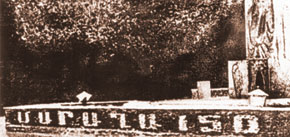 Monument erected on the 150th anniversary of the Armenian migration from Iran to Northern Azerbaijan. Nagorno-Karabagh (Agdere district). 1978 Then Veli Akhundov (the party leader in Azerbaijan. - I.N.) called me. It was a resolution by the Central Committee of the CPSU; it said: “... to charge Akhundov of the Central Committee of the CP of Azerbaijan and Kochinyan of the Central Committee of the CP of Armenia with discussing this question and reporting back”. What did that mean? In fact it meant that Armenia was entrusted with solving an Azerbaijani issue… I told him that it would be better to discuss this question in Moscow with Brezhnev. He left for Moscow and explained the situation to Brezhnev, who cancelled the resolution”12.
Monument erected on the 150th anniversary of the Armenian migration from Iran to Northern Azerbaijan. Nagorno-Karabagh (Agdere district). 1978 Then Veli Akhundov (the party leader in Azerbaijan. - I.N.) called me. It was a resolution by the Central Committee of the CPSU; it said: “... to charge Akhundov of the Central Committee of the CP of Azerbaijan and Kochinyan of the Central Committee of the CP of Armenia with discussing this question and reporting back”. What did that mean? In fact it meant that Armenia was entrusted with solving an Azerbaijani issue… I told him that it would be better to discuss this question in Moscow with Brezhnev. He left for Moscow and explained the situation to Brezhnev, who cancelled the resolution”12.
Thus, the territorial claims of Armenia to Azerbaijan had no basis, even before the collapse of the USSR, and always came to grief.
References
1. ‘The Karabagh question. Sources and essence in documents and facts’, p.77-78. Stepanakert, 1991
2. The newspaper “New time”. Yerevan. 20 August 2005
3. Archive of Political Documents of the Administrative office of the President of the Republic of Azerbaijan: F.1, 169, issue 249, p.2
4. Ibid, p.3-7
5. J.Hasanli, ‘The national question in Azerbaijan: Political management and intellectuals (1954-1959)’, p.111. Baku, 2008
6. Ibid, p. 108-109
7. V.Mikaelyan (editor), ‘Nagorno-Karabagh in 1918-1923: Collection of documents and materials’
http://www.arsakhworld.com. Yerevan: Academy of Sciences of Armenia, 1992
8. ‘History of Azerbaijan: 7 volumes’, vol.7, p.158. Baku, 2003
9. Y.Zubkova, S.Konstantinov, D.Lyukshin etc. (database compilers), ‘Ethnic conflicts in the USSR. 1917 – 1991’, http: // www. som.fsio.ru. 2001
10. S.Asadov (compiler), ‘Historical geography of Western Azerbaijan’, p.88-89. Baku, 1998
11. A.Kochinyan, ‘Documents, letters, memoirs’, p. 35-43. Yerevan, 2003
12. Quotation from a statement by H.Aliyev, President of the Republic of Azerbaijan, at a meeting with Azerbaijani intellectuals, ‘Baku worker’ newspaper, 12 November 1999.
About the author:Ilgar Niftaliyev is a senior scientific employee of the Department of Soviet-era Azerbaijani History in the A. Bakikhanov Institute of History of Azerbaijan’s National Academy of Sciences. He is the author of 30 articles on Armenian-Azerbaijani relations in the 20th century. His monograph “The Azerbaijan Soviet Socialist Republic in Armenian expansionist plans of the 1920s” was published in 2010.
by Ilgar Niftaliyev
When Nakhchivan was granted autonomous status in 1921 and the Autonomous Region of Nagorno-Karabagh (ARNK) was formed in 1923 as part of the Azerbaijan Soviet Socialist Republic (the original name of the ARNK before ratification of the second Constitution of the USSR in 1936) all Armenian territorial claims on Azerbaijan were laid to rest.
New claim
However, the situation changed after the Second World War. New territorial claims were launched by the leadership of the Armenian Soviet Socialist Republic. Grigory Arutyunov Secretary of the Central Committee of the Communist Party of the Armenian Soviet Socialist Republic, sent a telegram to Georgy Malenkov, Secretary of the Central Committee of the All-Russian Communist Party, trying to “give reasons” to transfer the ARNK to the Armenian Soviet Socialist Republic1. As Ruben Angaladyan, Armenian researcher and author of a book on Anastas Mikoyan, states, “Grigory Arutyunov could not have taken such a step without consulting Mikoyan. We must remember that Arutyunov’s daughter was Mikoyan’s daughter-in-law, the wife of his son, Alexey. So Mikoyan had, without doubt, been informed about these letters.”2
Rebuttal and withdrawal
When Malenkov forwarded Arutyunov´s telegram to Mir Jafar Baghirov, first secretary of the Central Committee of the Communist Party of Azerbaijan, on 28 November 19453, the Azerbaijani leader prepared a comprehensive response and sent it to Malenkov on 10 December 1945, together with an inquiry into the political history of Karabagh. Baghirov disproved Arutyunov’s ‘case’ in toto.
 M.J.Bagirov, First Secretary of the Azerbaijani Communist (Bolshevik) Party, and M.I.Kalinin, Chairman of the Supreme Presidium Staff of the USSR, at the 25th Anniversary of the establishment of Soviet power in Azerbaijan. 1945
M.J.Bagirov, First Secretary of the Azerbaijani Communist (Bolshevik) Party, and M.I.Kalinin, Chairman of the Supreme Presidium Staff of the USSR, at the 25th Anniversary of the establishment of Soviet power in Azerbaijan. 1945 National development / nationalist expansion
The thaw in the USSR’s political regime that began after Stalin´s death promoted greater sensitivity by the state to the moods of society. The 20th Congress of the CPSU, which took place in February 1956 and at which the new Soviet party leader, Nikita Khrushchev, denounced the personality cult surrounding Stalin, was the culmination of this process. As one historian accurately noted, the outcomes of the 20th Congress were received differently in the Soviet republics of the Southern Caucasus: “While they stimulated a struggle in Azerbaijan for development of the national language and values, in Armenia they revived the idea of making territorial claims on neighbouring republics and Turkey”5. A decree by the Presidium of the Supreme Council of the USSR, dated 19 February 1954, ‘On transferring the Crimean region from the RSFSR to the USSR’, on the tercentenary of Ukraine’s union with Russia, stimulated Armenian hopes of a revision of the borders.
New claim
The new campaign of territorial claims on Azerbaijan was not simply organised at party leadership level in Armenia. Signatures were collected and petitions and appeals made to the higher allied party and state bodies by various social groups. The key role thus belonged to radical intellectuals, who were important players in the heightening of interethnic tension with Azerbaijanis, especially, in the post-Stalin period. Prominent among the intellectuals were elements who were gaining popularity on the field of ethnic and national confrontation. So, in April 1956, Suren Tovmasyan, the new First Secretary of the Central Committee of the CP of the Armenian Soviet Socialist Republic, specified in a message to Moscow that a party meeting at one of the high schools and a session of the Writers’ Union of Armenia had made appeals for a revision of the borders with the Azerbaijan Soviet Socialist Republic6.
Church and politics
The Armenian-Gregorian Church, which had renewed its work after the Second World War, made its own contribution to heightening the nationalist mood among Armenians. For the Armenian-Gregorian Church, nationalist and political aims traditionally prevailed over religious function and it had long since served as a bond for Armenians who, after the loss of their own statehood, had been living as a broad diaspora. It is no coincidence that Catholicos Vazgen I, in a letter dated 12 May 1956 and addressed to Nikolai Bulganin, Chairman of the Council of Ministers of the USSR, tried to present the territorial claims on Georgia and Azerbaijan as primarily the demands of the Armenian Diaspora7. Although the questions raised in the letter went unanswered, the fact that this appeal to the Soviet leadership was made not by the Armenian party leader, but by the leading cleric was testimony that the Armenian elite, having tasted some freedom following ‘the thaw’ after Stalin’s death, had renewed their active attempts at expansion8.
The claim-again sixties
The 60s were marked by a stepping up of Armenian territorial claims. Operational information received by the ARNK KGB of the Azerbaijan Soviet Socialist Republic in May 1962, stresses that “some people in Stepanakert are spreading rumours about secession by the ARNK from Azerbaijan and joining Armenia. Signatures are being collected illegally for an appeal to the central authorities to allow union with Armenia. A similar appeal, signed by leading representatives of Karabagh intellectuals has already been directed to Moscow”. On 24 June 1962, the KGB of the Azerbaijan Soviet Socialist Republic received the following information: “In connection with Khruschev’s forthcoming visit to Armenia, rumours are circulating among the Armenian population of the region that once in Armenia, Khrushchev is going to present the country with the Nagorno-Karabagh region as a gift to commemorate the republic’s 40th anniversary9.
The next round of the antiAzerbaijani campaign coincided with preparations by the Armenian Soviet Socialist Republic for the 50th anniversary of the notorious events of 1915 in the Ottoman Empire. During this period in the Armenian Soviet Socialist Republic, Azerbaijanis were banned from supervisory posts, regional Azerbaijani-language newspapers were closed down, Yerevan’s Jafar Jabbarli Azerbaijani Drama Theatre ceased work and, at the same time, the ‘Karabagh Committee’ began to operate openly10.
Interference in internal affairs fails again
A change in the country’s leadership and Leonid Brezhnev’s arrival in office raised hopes among Armenia’s political elite of a favourable response to their territorial claims. On 30 September 1966, a letter signed by Anton Kochinyan, First Secretary of the Central Committee of the CP of the Armenian Soviet Socialist Republic, and Badal Muradyan, chairman of the Council of Ministers, which was presented as “the request of a group of scientists and cultural workers of the Armenian Soviet Socialist Republic to the 23rd party congress” was sent to the Central Committee of the CPSU. The authors of the letter, submitted forged historical documents connected with the formation of the ARNK and the Nakhchivan ASSR, and tried to prove their claims citing “political, economic and ethnic factors”, ostensibly supported by “numerous letters from various groups of workers of the ARNK received by the Central Committee of the CP of Armenia”. In conclusion, the authors cynically declared that while considering the questions raised “they proceeded from the main task of providing a further strengthening of fraternal friendship among the people of the Soviet Union and, in particular, between the Armenian and Azerbaijani peoples.”11 Recollecting these events, Heydar Aliyev, who was then Chairman of the KGB of the Azerbaijan Soviet Socialist Republic, noted: “I remember, it was either in 1966 or in 1967 that a resolution arrived from Moscow.
 Monument erected on the 150th anniversary of the Armenian migration from Iran to Northern Azerbaijan. Nagorno-Karabagh (Agdere district). 1978
Monument erected on the 150th anniversary of the Armenian migration from Iran to Northern Azerbaijan. Nagorno-Karabagh (Agdere district). 1978 Thus, the territorial claims of Armenia to Azerbaijan had no basis, even before the collapse of the USSR, and always came to grief.
References
1. ‘The Karabagh question. Sources and essence in documents and facts’, p.77-78. Stepanakert, 1991
2. The newspaper “New time”. Yerevan. 20 August 2005
3. Archive of Political Documents of the Administrative office of the President of the Republic of Azerbaijan: F.1, 169, issue 249, p.2
4. Ibid, p.3-7
5. J.Hasanli, ‘The national question in Azerbaijan: Political management and intellectuals (1954-1959)’, p.111. Baku, 2008
6. Ibid, p. 108-109
7. V.Mikaelyan (editor), ‘Nagorno-Karabagh in 1918-1923: Collection of documents and materials’
http://www.arsakhworld.com. Yerevan: Academy of Sciences of Armenia, 1992
8. ‘History of Azerbaijan: 7 volumes’, vol.7, p.158. Baku, 2003
9. Y.Zubkova, S.Konstantinov, D.Lyukshin etc. (database compilers), ‘Ethnic conflicts in the USSR. 1917 – 1991’, http: // www. som.fsio.ru. 2001
10. S.Asadov (compiler), ‘Historical geography of Western Azerbaijan’, p.88-89. Baku, 1998
11. A.Kochinyan, ‘Documents, letters, memoirs’, p. 35-43. Yerevan, 2003
12. Quotation from a statement by H.Aliyev, President of the Republic of Azerbaijan, at a meeting with Azerbaijani intellectuals, ‘Baku worker’ newspaper, 12 November 1999.
About the author:Ilgar Niftaliyev is a senior scientific employee of the Department of Soviet-era Azerbaijani History in the A. Bakikhanov Institute of History of Azerbaijan’s National Academy of Sciences. He is the author of 30 articles on Armenian-Azerbaijani relations in the 20th century. His monograph “The Azerbaijan Soviet Socialist Republic in Armenian expansionist plans of the 1920s” was published in 2010.
